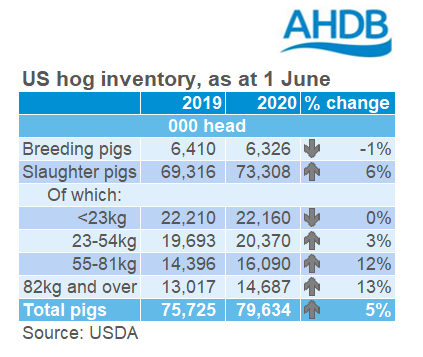Ample supplies set to come onto US market
Tuesday, 7 July 2020
By Felicity Rusk
The US pig herd has continued to expand, despite the significant challenges the COVID-19 pandemic has posed to the industry. As at 1 June, pig numbers totalled 79.63 million, 5% more than at the same point in the previous year.
The rise comes from a significant increase in the number of slaughter pigs, which recorded a 6% increase on the year. The majority of this uplift came from pigs weighing between 54-81kg and 82kg and over, which recorded an uplift of 12% and 13% respectively. The uplift in these weight bands translates into an additional 3.36 million pigs compared to the same point in the previous year.
Processing capacity was severally disrupted in the spring due to the pandemic. Before the latest pig inventory was released, Rabobank estimated that the plant closures would have generated a backlog of about 3 million market-ready pigs. However, these figures suggest the actual backlog is smaller than this, because some extra pigs would be available this year anyway due to expansion.
Unfortunately, euthanasia of market-ready pigs was the only option for some processors. Analysis from David Miller, Chief Economist at Decision Innovation Solutions, suggests over 2 million market-ready pigs were either euthanized or disappeared through direct sales, which would leave a backlog of about 1.2 million market-ready pigs. Although, as the survey was conducted at the start of June, it cannot take account of actions taken later that month.
Even so, the uplift in the heavier weight groups suggests that there will a large supply of pigs to come onto the market for the rest of the year. This will likely continue to put pressure on processing capacity as they work through the backlog. Furthermore, there are growing concerns over weaker demand later in the year. Subdued demand in combination with the expected large supplies would put downwards pressure on US pig prices.

In contrast, the breeding herd recorded a reduction in numbers. As at 1 June, the US breeding herd totalled 6.33 million head, 1% less than both the same point in the previous year and the previous quarter. The US pig herd has been in an expansion phase for several years. However, the difficult market outlook now seems to have driven some herd liquidation. Farrowing intentions for the coming months are also 5% below year earlier levels.
Between March and May, around half of the breeding pigs in the US farrowed. Sow productivity remained relatively flat on the year, only recording a marginal 0.01 improvement in pigs weaned per litter, to average 11.01. Nevertheless, this remains the highest pigs per litter for the March-May period on record. The pig crop between March and May totalled 34.93 million, 1% more than in the previous year.
Sign up for regular updates
Subscribe to receive pork market news straight to your inbox. Simply complete our online form.
While AHDB seeks to ensure that the information contained on this webpage is accurate at the time of publication, no warranty is given in respect of the information and data provided. You are responsible for how you use the information. To the maximum extent permitted by law, AHDB accepts no liability for loss, damage or injury howsoever caused or suffered (including that caused by negligence) directly or indirectly in relation to the information or data provided in this publication.
All intellectual property rights in the information and data on this webpage belong to or are licensed by AHDB. You are authorised to use such information for your internal business purposes only and you must not provide this information to any other third parties, including further publication of the information, or for commercial gain in any way whatsoever without the prior written permission of AHDB for each third party disclosure, publication or commercial arrangement. For more information, please see our Terms of Use and Privacy Notice or contact the Director of Corporate Affairs at info@ahdb.org.uk © Agriculture and Horticulture Development Board. All rights reserved.

